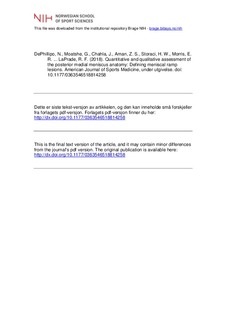| dc.contributor.author | DePhillipo, Nicholas | |
| dc.contributor.author | Moatshe, Gilbert | |
| dc.contributor.author | Chahla, Jorge | |
| dc.contributor.author | Aman, Zachary S. | |
| dc.contributor.author | Storaci, Hunter W. | |
| dc.contributor.author | Morris, Elizabeth R. | |
| dc.contributor.author | Robbins, Colin M. | |
| dc.contributor.author | Engebretsen, Lars | |
| dc.contributor.author | LaPrade, Robert F. | |
| dc.date.accessioned | 2019-04-26T09:24:46Z | |
| dc.date.available | 2019-04-26T09:24:46Z | |
| dc.date.created | 2018-12-13T11:30:50Z | |
| dc.date.issued | 2018 | |
| dc.identifier.citation | American Journal of Sports Medicine. 2018, 47, 372-378. | nb_NO |
| dc.identifier.issn | 0363-5465 | |
| dc.identifier.uri | http://hdl.handle.net/11250/2595657 | |
| dc.description | I Brage finner du siste tekst-versjon av artikkelen, og den kan inneholde ubetydelige forskjeller fra forlagets pdf-versjon. Forlagets pdf-versjon finner du på sagepub.com http://dx.doi.org/10.1177/0363546518814258 / In Brage you'll find the final text version of the article, and it may contain insignificant differences from the journal's pdf version. The definitive version is available at sagepub.com http://dx.doi.org/10.1177/0363546518814258 | nb_NO |
| dc.description.abstract | Background: Meniscal ramp lesions have been defined as a tear of the peripheral attachment of the posterior horn of the medial meniscus (PHMM) at the meniscocapsular junction or an injury to the meniscotibial attachment. Precise anatomic descriptions of these structures are limited in the current literature. Purpose: To quantitatively and qualitatively describe the PHMM and posteromedial capsule anatomy pertaining to the location of a meniscal ramp lesion with reference to surgically relevant landmarks. Study Design: Descriptive laboratory study. Methods: Fourteen male nonpaired fresh-frozen cadavers were used. The locations of the posteromedial meniscocapsular and meniscotibial attachments were identified. Measurements to surgically relevant landmarks were performed with a coordinate measuring system. To further analyze the posteromedial meniscocapsular and meniscotibial attachments, hematoxylin and eosin and alcian blue staining were conducted on a separate sample of 10 nonpaired specimens. Results: The posterior meniscocapsular attachment had a mean 6 SD length of 20.2 6 6.0 mm and attached posteroinferiorly to the PHMM at a mean depth of 36.4% of the total posterior meniscal height. The posterior meniscotibial ligament attached on the PHMM 16.5 mm posterior and 7.7 mm medial to the center of the posterior medial meniscal root attachment. The meniscotibial ligament tibial attachment was 5.9 6 1.3 mm inferior to the articular cartilage margin of the posterior medial tibial plateau. The posterior meniscocapsular attachment converged with the meniscotibial ligament at the most posterior point of the meniscocapsular junction in all specimens. Histological staining of the meniscocapsular and meniscotibial ligament PHMM attachments showed similar structure, cell density, and fiber directionality, with no qualitative difference in the makeup of their collagen matrices across all specimens. Conclusion: The anatomy of the area where a medial meniscal ramp tear occurs revealed that the 2 posterior meniscal attachments merged at a common attachment on the PHMM. Histological analysis validated a shared attachment point of the meniscocapsular and meniscotibial attachments of the PHMM. | nb_NO |
| dc.language.iso | eng | nb_NO |
| dc.subject | knee | nb_NO |
| dc.subject | ramp lesion | nb_NO |
| dc.subject | medial meniscus | nb_NO |
| dc.subject | quantitative anatomy | nb_NO |
| dc.title | Quantitative and Qualitative Assessment of the Posterior Medial Meniscus Anatomy : Defining Meniscal Ramp Lesions | nb_NO |
| dc.type | Journal article | nb_NO |
| dc.type | Peer reviewed | nb_NO |
| dc.description.version | acceptedVersion | nb_NO |
| dc.source.pagenumber | 372-378 | nb_NO |
| dc.source.volume | 47 | nb_NO |
| dc.source.journal | American Journal of Sports Medicine | nb_NO |
| dc.source.issue | 2 | nb_NO |
| dc.identifier.doi | 10.1177/0363546518814258 | |
| dc.identifier.cristin | 1642614 | |
| dc.description.localcode | Seksjon for idrettsmedisinske fag / Department of Sport Medicine | nb_NO |
| cristin.unitcode | 150,34,0,0 | |
| cristin.unitname | Seksjon for idrettsmedisinske fag | |
| cristin.ispublished | true | |
| cristin.fulltext | postprint | |
| cristin.qualitycode | 2 | |
